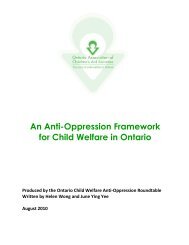English - Ontario Association of Children's Aid Societies
English - Ontario Association of Children's Aid Societies
English - Ontario Association of Children's Aid Societies
You also want an ePaper? Increase the reach of your titles
YUMPU automatically turns print PDFs into web optimized ePapers that Google loves.
FAMILY VIOLENCE<br />
Family violence in Aboriginal families includes male violence against women,<br />
violence between intimate partners, between siblings, between parents and children,<br />
and between parents and Elders. Family violence includes violent behaviour that<br />
occurs between family members in the immediate and extended family.<br />
First Nations and Inuit women in particular experience higher rates <strong>of</strong> family violence<br />
than non-Aboriginal women. A 2004 Statistics Canada study showed that Aboriginal<br />
women were three and a half times more likely to suffer some form <strong>of</strong> spousal violence<br />
than non-Aboriginal women.<br />
Statistics Canada interpreted the findings <strong>of</strong> the 2004 General Social Survey, and<br />
discovered the following trends:<br />
> > 24% <strong>of</strong> Aboriginal women reported spousal violence in the preceding five years<br />
> > 7% non-Aboriginal women reported spousal violence in the preceding five<br />
years<br />
> > 43% <strong>of</strong> Aboriginal victims <strong>of</strong> spousal violence reported injuries<br />
> > 31% <strong>of</strong> non-Aboriginal victims <strong>of</strong> spousal violence reported injuries<br />
The <strong>Ontario</strong> Native Women’s <strong>Association</strong> (ONWA) and the <strong>Ontario</strong> Federation <strong>of</strong> Indian<br />
Friendship Centres (OFIFC) have studied family violence in Canada and in <strong>Ontario</strong>.<br />
The 1989 ONWA study entitled Breaking Free found that eight out <strong>of</strong> 10 Aboriginal<br />
women in <strong>Ontario</strong> had personally experienced family violence.<br />
The statistics listed below provide additional information about family violence in<br />
Canada, and in <strong>Ontario</strong>:<br />
> > In some northern Aboriginal communities, it is believed that between 75 and<br />
90 percent <strong>of</strong> Aboriginal women are battered<br />
> > Aboriginal women run eight times the risk <strong>of</strong> being killed by their spouse after<br />
a separation, compared to non-Aboriginal women<br />
> > Thirty-seven percent <strong>of</strong> Aboriginal women experienced emotional or financial<br />
abuse from a current spouse, in comparison to 18 percent <strong>of</strong> non-Aboriginal<br />
women<br />
> > Ninety percent <strong>of</strong> federally sentenced Aboriginal women have histories <strong>of</strong><br />
physical and/or sexual abuse<br />
Children witness more than half <strong>of</strong> the violence that occurs between the adults in<br />
the home and are also targets for abuse, especially sexual crimes, with up to three<br />
quarters <strong>of</strong> Aboriginal girls under the age <strong>of</strong> 18 having been sexually assaulted.<br />
INTERGENERATIONAL VIOLENCE<br />
30<br />
As the Harmony Circles explain, the family and the community surrounds the<br />
individual. Researchers have learned that violent behaviour is learned, through the<br />
interaction with others and by observing violent behaviour. Social Learning Theory

















